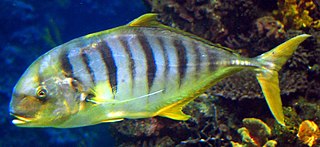 W
WThe golden trevally, also known as the golden kingfish, banded trevally and king trevally, is a species of large marine fish classified in the jack and horse mackerel family Carangidae, and the only member of the monospecific genus Gnathanodon. The golden trevally is widely distributed throughout the tropical and subtropical waters of the Indian and Pacific Oceans, ranging from South Africa in the west to Central America in the east, extending to Japan in the north and Australia in the south. The species predominantly occupies inshore waters where it inhabits both reef and sandy substrates. The golden trevally is easily distinguished from its relatives by its fleshy, rubbery lips and unique colouration, which ranges from bright yellow with black bars as a juvenile to a golden-silvery colour as an adult. It is known to grow to 120 cm in length and 15 kg in weight. The golden trevally schools as a juvenile, often closely following larger objects including sharks and jellyfish. The species uses its protractile jaws to suck out prey from the sand or reef, and consumes a variety of fish, crustaceans and molluscs. Spawning aggregations gather at night at different times of the year throughout its range. The golden trevally is a considerable constituent of several Middle Eastern fisheries and being of minor importance to many others, with a worldwide annual catch of 1187 t to 3475 t recorded between 2000 and 2010. The golden trevally is a popular gamefish, taken by bait, lure, fly and also spear throughout its range. Several Asian countries currently farm the fish in caged aquaculture. Due to their brilliant colouration, juveniles are popular in marine aquaria.
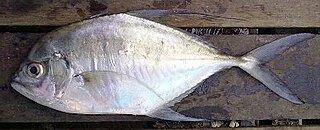 W
WUlua is a genus of trevallies in the family Carangidae. They are native to the Indian Ocean and the western Pacific Ocean.
 W
WThe old woman angelfish is a large angelfish growing up to 45 cm, found in the western Indian Ocean. Adult P. rhomboides are brown with the back third of the body being light blue whilst immature specimens are black with wavering blue and white bands, these specimens can be confused with many other Pomacanthus angelfish because of their very similar coloration. Adults of this species can often be found in small groups feeding at the surface or in midwater whilst immature specimens are usually found singularly in tidal pools.
 W
WThe bludger, also known as the bludger trevally, nakedbreast trevally or Bleeker's jackfish, is a widespread species of large marine fish in the jack family, Carangidae. The bludger inhabits the tropical and subtropical regions of the Indo-west Pacific Ocean, distributed from South Africa in the west to Japan and New Caledonia in the east. It is a large fish, growing to a maximum recorded length of 90 cm, and is very similar to the yellowspotted trevally, Carangoides fulvoguttatus, but can be separated by the complete absence of breast scales and a number of other anatomical features. The species inhabits moderately deep offshore coral and rocky reefs, where it preys on small crustaceans and fish. The reproductive biology of the species is poorly known, but it appears to move to more tropical waters to spawn. The bludger is of intermediate importance to fisheries throughout its range, taken by hook and line and various netting methods. It is of some value to anglers also, considered a good gamefish, but generally regarded as poor eating due to its soft oily flesh, which is used as bait by many anglers. The name ‘bludger’ is said to either refer to the blunt head of the species, or the destination of the fish when caught by professional fishermen who treat the fish as discard.
 W
WThe Seychelles butterflyfish is a species of butterflyfish. It is found in the Indian Ocean from eastern Africa east to Cocos-Keeling Islands and Christmas Island, north to Sri Lanka. The Seychelles butterflyfish is found in areas of rich coral growth on seaward reefs, at 10–40 m depth.
 W
WThe yellow teardrop butterflyfish or Indian teardrop butterflyfish is a butterflyfish of the family Chaetodontidae found in the Indian ocean from East Africa, to Sumatra, Indonesia.
 W
WThe veined catfish, also known as the marine catfish, is a species of sea catfish in the family Ariidae. It was described by Achille Valenciennes in 1840. It inhabits tropical marine and brackish waters in the Indo-western Pacific region, including the Mozambique Channel, Myanmar, Indonesia and southern China. It dwells at a depth range of 20 to 50 m. It reaches a maximum total length of 30 cm (12 in), but more commonly reaches a TL of 19 cm (7.5 in).
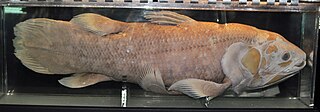 W
WThe West Indian Ocean coelacanth, sometimes known as gombessa, African coelacanth, or simply coelacanth, is one of two extant species of coelacanth, a rare order of vertebrates more closely related to lungfish and tetrapods than to the common ray-finned fishes. Latimeria chalumnae is a crossopterygian.
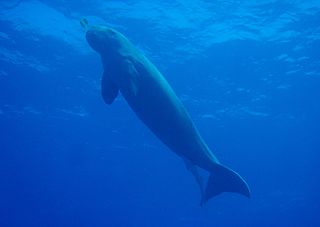 W
WThe dugong is a medium-sized marine mammal. It is one of four living species of the order Sirenia, which also includes three species of manatees. It is the only living representative of the once-diverse family Dugongidae; its closest modern relative, Steller's sea cow, was hunted to extinction in the 18th century.
 W
WThe comb flounder is a flatfish of the family Pleuronectidae. It is a demersal fish that lives on saltwater bottoms at depths of between 20 and 406 metres. Its natural habitat is the tropical waters of the western Indian Ocean, from KwaZulu-Natal and Mozambique in Southern Africa, to coastal Tanzania and Kenya in the African Great lakes region, to Somalia in the Horn of Africa, to Karnataka and Maharashtra in India. It can grow up to 19 centimetres (7.5 in) in length.
 W
WThe smooth grouper is a species of marine ray-finned fish, a grouper from the subfamily Epinephelinae which is part of the family Serranidae, which also includes the anthias and sea basses. It is associated with reefs and is found in the western Indian Ocean.
 W
WThe giant guitarfish, also known as the whitespotted wedgefish is a large species of guitarfish in the family Rhinidae. It is restricted to the Red Sea, Persian Gulf, and western Indian Ocean, but was formerly considered more widespread due to confusion with its relatives.
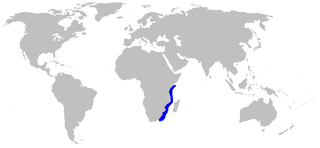 W
WThe thorny lanternshark is a shark of the family Etmopteridae found in the western Indian Ocean between latitudes 0° and 31°S, at depths between 200 and 500 m. Its length is up to 27 cm.
 W
WThe bluespotted stingray, also known as the bluespotted maskray or Kuhl's stingray, is a species of stingray of the family Dasyatidae. It was recently changed from Dasyatis kuhlii in 2008 after morphological and molecular analyses show that it is part of a distinct genus, Neotrygon. The body is rhomboidal and colored green with blue spots. Maximum disk width is estimated 46.5 centimeters (18.3 in). It is popular in aquaria but usually not distinguished from the bluespotted ribbontail ray. The ribbontail has a rounded body, is a brighter green with brighter blue and more vivid spots, but the bluespotted stingray is larger. The stingray's lifespan is estimated thirteen years of age for females and ten years for males. The bluespotted stingray preys on many fish and small mollusks. The bluespotted stingray is also generally found from Indonesia to Japan, and most of Australia. The bluespotted stingray is also targeted by many parasites such as tapeworms, flatworms, and flukes.
 W
WThe geometric moray is a moray eel of the family Muraenidae found throughout the western Indian Ocean at depths to 40 m. Its length is up to 65 cm.
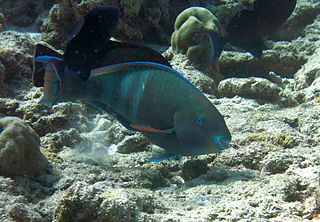 W
WThe eclipse parrotfish, also known as Russell's parrotfish, is a species of parrotfish native to Indian ocean countries such as Madagascar, Seychelles, and Mauritius to south India, Sri Lanka and Thailand. They inhabit waters over rocky substrates at depths from 6 to 15 m. The maximum length is 51.0 cm (20.1 in), and weight reaches 1.1 kg (2.4 lb).
 W
WPhestilla minor is a species of sea slug, an aeolid nudibranch, a marine gastropod mollusk in the family Trinchesiidae. The species feeds on the hard coral genus Porites and has been found to represent a species complex.
 W
WThe black pomfret is a species of carangid native to reefs of the Indian Ocean and the western Pacific Ocean, where it is found at depths from 15 to 105 m, though it is rarely found deeper than 40 m (130 ft). This species grows to 75 cm (30 in) in total length and is very important to local commercial fisheries. This species is the only known member of its genus.
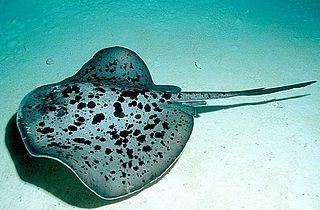 W
WThe round ribbontail ray is a species of stingray in the family Dasyatidae, found throughout the nearshore waters of the tropical Indo-Pacific, as well as off islands in the eastern Pacific. It is a bottom-dwelling inhabitant of lagoons, estuaries, and reefs, generally at a depth of 20–60 m (66–197 ft). Reaching 1.8 m (5.9 ft) across, this large ray is characterized by a thick, rounded pectoral fin disc covered by small tubercles on top, and a relatively short tail bearing a deep ventral fin fold. In addition, it has a variable but distinctive light and dark mottled pattern on its upper surface, and a black tail.
 W
WRhina ancylostoma, the bowmouth guitarfish, shark ray or mud skate, is a species of ray and a member of the family Rhinidae. Its evolutionary affinities are not fully resolved, though it may be related to true guitarfishes and skates. This rare species occurs widely in the tropical coastal waters of the western Indo-Pacific, at depths of up to 90 m (300 ft). Highly distinctive in appearance, Rhina ancylostoma has a wide and thick body with a rounded snout and large shark-like dorsal and tail fins. Its mouth forms a W-shaped undulating line, and there are multiple thorny ridges over its head and back. It has a dorsal color pattern of many white spots over a bluish gray to brown background, with a pair of prominent black markings over the pectoral fins. This large species can reach a length of 2.7 m (8.9 ft) and weight of 135 kg (298 lb).
 W
WThe Indian Scad, also known as the Northern mackerel scad, round scad, Russell's mackerel scad, slender scad or the three lined grunter, is a species of ray-finned fish of the genus Decapterus which is part of the family Carangidae and which occurs in the Indian Ocean. It has colonised the eastern Mediterranean through the Suez Canal. It is an important species in coastal fisheries throughout its range.
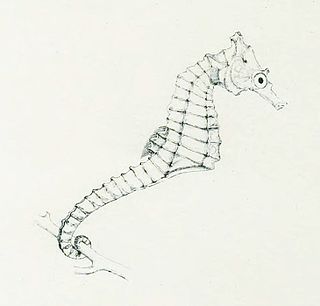 W
WThe giraffe seahorse is a species of fish of the family Syngnathidae. It is found in coastal waters off of the south and east coasts of Africa, from South Africa to Tanzania, and possibly north to Kenya. It lives in estuarine seagrass beds, algae beds, and shallow reefs to depths of 45 metres (148 ft), where it can grow to lengths of 10 centimetres (3.9 in). It is expected to feed on small crustaceans, similar to other seahorses. This species is ovoviviparous, with males carrying eggs in a brood pouch before giving birth to live young. Individuals are sexually mature at around 6.5 centimetres (2.6 in). Major threats to this species could be habitat loss, through coastal development and pollution, and overexploitation through bycatch. Some other threats include human use by drying out the seahorse for traditional medicine or as a curio.
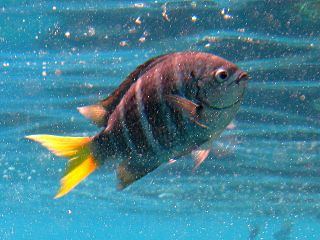 W
WThe yellowtail sergeant is a species of damselfish in the family Pomacentridae. They are found in the Indo-Pacific. It can grow up to a maximum length of 17 centimetres (6.7 in).
 W
WThe milk shark is a species of requiem shark, and part of the family Carcharhinidae, whose common name comes from an Indian belief that consumption of its meat promotes lactation. The largest and most widely distributed member of its genus, the milk shark typically measures 1.1 m (3.6 ft) long, and can be found in coastal tropical waters throughout the eastern Atlantic and the Indo-Pacific regions. Occurring from the surface to a depth of 200 m (660 ft), this species is common near beaches and in estuaries, and has been recorded swimming up rivers in Cambodia. Juveniles are known to inhabit tidal pools and seagrass meadows. The milk shark has a slender body with a long, pointed snout and large eyes, and is a nondescript gray above and white below. This shark can be distinguished from similar species in its range by the long furrows at the corners of its mouth, and seven to 15 enlarged pores just above them.
 W
WThe pigeye shark or Java shark is an uncommon species of requiem shark, in the family Carcharhinidae, found in the warm coastal waters of the eastern Atlantic and western Indo-Pacific. It prefers shallow, murky environments with soft bottoms, and tends to roam within a fairly localised area. With its bulky grey body, small eyes, and short, blunt snout, the pigeye shark looks almost identical to the better-known bull shark. The two species differ in vertebral count, the relative sizes of the dorsal fins, and other subtle traits. This shark typically reaches lengths of 1.9–2.5 m (6.2–8.2 ft).
 W
WThe sliteye shark is a species of requiem shark, in the family Carcharhinidae, and the only member of its genus. It is found in the tropical waters of the Indo-West Pacific between latitudes 34° N and 30° S, from depths of 7 to 100 m. It can reach a length of about 95 cm.
 W
WThe zebra shark is a species of carpet shark and the sole member of the family Stegostomatidae. It is found throughout the tropical Indo-Pacific, frequenting coral reefs and sandy flats to a depth of 62 m (203 ft). Adult zebra sharks are distinctive in appearance, with five longitudinal ridges on a cylindrical body, a low caudal fin comprising nearly half the total length, and usually a pattern of dark spots on a pale background. Young zebra sharks under 50–90 cm (20–35 in) long have a completely different pattern, consisting of light vertical stripes on a brown background, and lack the ridges. This species attains a length of 2.5 m (8.2 ft).
 W
WThe blacktip tope, also known as pencil shark or blacktip topeshark, is a houndshark of the family Triakidae, and the only member of the genus Hypogaleus. It is found in the deep waters of the continental shelf in the Indo-West Pacific, from East Africa to Japan, at depths between 40 and 230 m. It can grow up to a length of 1.27 m.
 W
WThe blacktip trevally, also known as the blacktip kingfish or yellowtail kingfish, is a species of large marine fish classified in the jack family Carangidae. The blacktip trevally is distributed throughout the tropical to subtropical Indian and West Pacific Oceans, ranging from South Africa in the west to Fiji, Japan and northern Australia in the east. It inhabits coastal waters throughout its range, preferring moderately deep clear waters over rocky and coral reefs. The blacktip trevally is easily distinguished by its yellow fins and a dark upper caudal fin lobe which gives the species its common name, as well as a host of other anatomical features. The species is known to reach a maximum size of 1 m. It is a benthopelagic predator, commonly forming small shoals where it takes a variety of fishes, cephalopods and crustaceans as prey. Little is known of reproduction in the species, and spawning is assumed to take place in more tropical regions of its range, with juveniles known to inhabit bays and large estuaries. Blacktip trevally are often caught using hook and line and various nets in commercial fisheries although don't make up a large part of the market. They are also popular with anglers due to their fighting ability and decent table qualities.
 W
WThe blue trevally, also known as the banded trevally, barred trevally, Ferdau's trevally or Forskaal's jackfish, is a common, widespread species of pelagic marine fish classified in the jack family, Carangidae. The blue trevally is distributed throughout the tropical and subtropical waters of the Indo-Pacific and central Pacific regions, ranging from South Africa in the west to Hawaii in the east. It is a moderately large fish, growing to a recorded maximum length of 70 cm, with the number of rays in the second dorsal fin and the colouring serving as diagnostic features of the species. The species inhabits waters to depths of 60 m, generally inhabiting reefs, beaches, lagoons, and areas with sandy substrates. It is a predatory fish, taking other fish, prawns, crabs, and molluscs, and very little is known of the species' reproductive biology. The blue trevally is of varying importance to fisheries throughout its range, with some regions having high catches of the fish. It is considered to be a gamefish, and is sought after for its excellent eating qualities.
 W
WThe brassy trevally, Caranx papuensis is a species of large marine fish classified in the jack family, Carangidae.
 W
WThe cleftbelly trevally, also known as the cleftbelly kingfish, Kuweh trevally or thin crevalle, is a species of tropical marine fish of the jack family, Carangidae. The species inhabits coastal waters throughout the Indo-West Pacific region from South Africa in the west to Japan in the east, often found near the water's surface. The cleftbelly trevally is the only member of the genus Atropus and is distinguished by a number of anatomical characteristics, with a deep median groove in the belly giving the species its common name. It is not a large fish, growing to a maximum recorded length of 26.5 cm. Cleftbelly trevally are predatory fish, taking a variety of small crustaceans and fish. The species is of minor importance to fisheries throughout its range.
 W
WThe coastal trevally, also known as the onion trevally, Japanese trevally or bluefin kingfish, is a species of inshore marine fish in the jack family Carangidae. The species is distributed throughout the tropical and subtropical waters of the Indian and west Pacific Oceans, from South Africa in the west to Japan and New Caledonia in the east, reaching as far south as Australia. The species is found on deep coastal reefs, both in schools and as solitary individuals, where they prey on small midwater organisms including crustaceans, small fish and cephalopods. The species is taken as bycatch in a number of fisheries throughout its range by a number of fishing methods and is of little commercial value, but is considered to be a good table fish. A mistype in the original volume in which Eduard Rüppell named the species led to the combination Carangoides caeruleopinnatus, which has incorrectly spread through the literature.
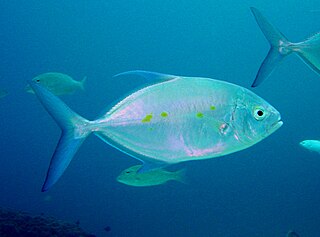 W
WThe island trevally, island jack, thicklip trevally or false bluefin trevally is a widespread species of offshore marine fish classified in the jack family Carangidae. The island trevally is common through the tropical regions of the Indian and Pacific Oceans, ranging from Mozambique and the Seychelles in the west to Hawaii and the Revillagigedo Islands in the central and eastern Pacific. The species is almost completely absent from the continental shelves, instead inhabiting offshore islands, where it is found in lagoons and on reef systems. It is a moderately large fish, growing to a maximum recorded length of 75 cm and 6.6 kg in weight, and is distinguishable by its angular snout and yellow spots, as well as more detailed anatomical features. The island trevally often moves in small schools, preying on a variety of small fishes and crustaceans. It is of moderate importance to fisheries throughout its range, often taken by trawls, hook-and-line, and various inshore netting methods, and is sold fresh or salted at market.
 W
WThe longfin trevally, also known as the longfin kingfish, longfin cavalla or armed trevally, is a species of inshore marine fish in the jack family, Carangidae. The species is common in tropical to subtropical waters of the Indo-Pacific, ranging from South Africa in the west to Japan in the east, typically inhabiting inshore reefs and bays. The species is easily distinguished by its elongate dorsal and anal fin lobes and filamentous dorsal rays, as well as its scaleless breast. Longfin trevally are pelagic predators, taking a variety of small fish, cephalopods and crustaceans, and reach sexual maturity at around 21 cm. The species has a maximum known length of 57 cm and weight of 3.5 kg. The longfin trevally has a very complex taxonomic history which is closely intertwined with another currently valid species, Carangoides ciliarius, which may yet prove to be synonymous. Longfin trevally are of minor importance to fisheries throughout their range and are considered good table fish, and are occasionally taken by anglers.
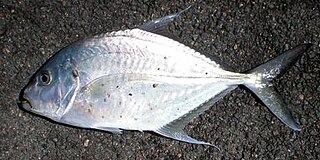 W
WThe longnose trevally, also known as the tea-leaf trevally, club-nosed trevally, grunting trevally or dusky trevally, is a species of inshore marine fish in the jack family, Carangidae. The species is distributed throughout the tropical and subtropical waters of the Indian and west Pacific Oceans from South Africa to New Zealand and Japan, inhabiting coastal waters, especially reefs, to a depth of 90 m. The longnose trevally is distinguished from similar species by a combination of a scaleless breast and the number of gill rakers and fin rays. It is a moderately large fish, growing to a maximum known length of 72 cm and 4.35 kg. The longnose trevally is a predatory fish, consuming small fish, crustaceans and molluscs. The species is of minor commercial importance throughout its range, and is considered to be a good table fish.
 W
WThe Malabar trevally, also known as the Malabar jack, Malabar kingfish or nakedshield kingfish, is a species of large inshore marine fish of the jack family, Carangidae. It is distributed throughout the Indian and west Pacific Oceans from South Africa in the west to Japan and Australia in the east, inhabiting reefs and sandy bays on the continental shelf. The Malabar trevally is similar to many of the other species in the genus Carangoides, with the number of gill rakers and the grey-brown colour of the tongue being the diagnostic features. The Malabar trevally is a predator, taking a variety of small fish, cephalopods and crustaceans. The species is of minor economic importance throughout its range, caught by a variety of net and handline methods.
 W
WThe tille trevally, also known as the tille kingfish, is a species of large marine fish classified in the jack family, Carangidae. The tille trevally is distributed through the tropical and subtropical waters of the Indo-Pacific region, ranging from South Africa in the west to Fiji, Japan and Australia in the east. The species is best distinguished by its rounded, strongly convex anterior profile, with other detailed anatomical features also useful. The tille trevally reaches a maximum length of 80 cm and a weight of 7.2 kg. It is predominantly an inshore species, inhabiting coastal reef and lagoon environments, although has been recorded on deep offshore seamounts. It is a predatory fish, taking various species of fish and crustaceans as prey, with little known of its reproductive cycle. It is of minor importance to fisheries throughout its range, taken by hook and line, gill nets and purse seines. The tille trevally is also considered a good game fish, and an excellent table fish. The species acquired its scientific and common names from a local name used by Pondicherry fishermen, koton tille, which Georges Cuvier then used when he named the species in 1833.
 W
WThe yellowspotted trevally, also known as the yellowspotted kingfish, goldspotted trevally or tarrum, is a widespread species of large inshore marine fish in the jack family Carangidae. The yellowspotted trevally inhabits the tropical and subtropical waters of the western Indo-Pacific region, from South Africa in the west to Japan and Australia in the east. The species is known to grow to a maximum length of at least 1.2 m, and is distinguished by gill raker and fin morphology, as well as the distinctive golden spots which give the fish its name. The yellowspotted trevally generally prefers inshore rocky and coral reefs, but is occasionally found over deep offshore sand banks to a depth of 100 m. It is a predatory fish, taking fish, cephalopods, and crustaceans, and shows diet partitioning with other trevallies in studies conducted in Australian waters. Reproduction is poorly studied, although observational evidence suggests spawning occurs in aggregations, probably during summer in South Africa. It is generally of minor importance to commercial fisheries throughout its range, but is considered an excellent sportfish by anglers and spearfishermen, and a good table fish.
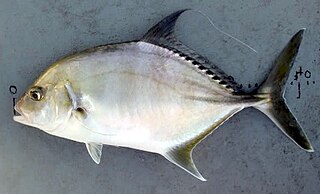 W
WThe coachwhip trevally, also known as the oblong trevally or oblique-banded trevally, is a species of inshore marine fish classified in the jack family Carangidae. The coachwhip trevally is distributed through the Indo-west Pacific region, ranging from South Africa in the west to Fiji and Japan in the east. It is a moderately large fish, growing to a known maximum length of 46 cm and can be distinguished from similar species by an array of detailed morphological features including dentition, fin ray counts and scale patterns. The coachwhip trevally inhabits coastal waters throughout its range, known to prefer estuarine waters in a number of localities. Nothing is known of its diet or reproductive biology, and is of little importance to fisheries, occasionally taken as bycatch in trawl and hook and line fisheries.
 W
WThe reticulate whipray or honeycomb stingray is a species of stingray in the family Dasyatidae. It inhabits coastal and brackish waters across the Indo-Pacific region from South Africa to Taiwan to Australia, favoring sandy habitats. A large species reaching 2 m (6.6 ft) in width, the reticulate whipray has a diamond-shaped pectoral fin disc and an extremely long tail without fin folds. Both its common and scientific names refer to its ornate dorsal color pattern of many small, close-set dark spots or reticulations on a lighter background. However, the reticulate whipray is only one of several large spotted stingrays in the Indo-Pacific which, coupled with the variability of its coloration with age and locality, has resulted in a great deal of taxonomic confusion.